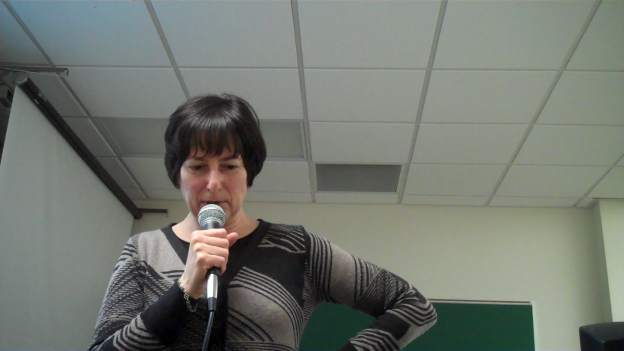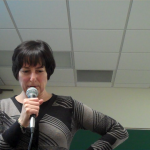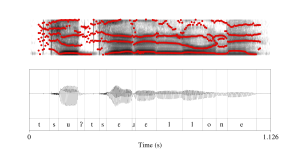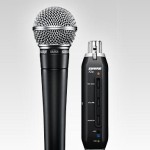How I used a specialty microphone in a phonetics course
0June 19, 2014 by Garrett Mitchener

In the spring 2014 semester, I ran a special topics course on phonetics and speech analysis. I invited students from many majors to take it, so there were students majoring in math, physics, computer science, Spanish, and some master’s students in math. I decided to apply for a TLT Un-grant for something a bit unusual: a specialty microphone. Specifically, I got a Shure SM58 with a USB adapter.
Microphones can be kind of tricky. The SM58 is a unidirectional cardioid microphone, specialized for picking up voices. It only registers sound from a small area directly in front of the head. You have to speak or sing very directly into this kind of microphone. If you’ve ever seen performers holding a microphone so close to their mouth that they look like they’re about to swallow it, it was probably an SM58 or something similar. Since it only detects sound in a small area, it doesn’t pick up sound coming from nearby speakers, which limits screeching feedback. It also mostly ignores other performers, which enables sound technicians to use a mixing board to balance out multiple musicians, enhance a soloist, and reduce noise from the audience.
Since the SM58 is designed for use during performances, it has an XLR socket for connecting to standard audio cables. The USB adapter that came with this particular microphone has an XLR plug on one end, and connects to a computer through a USB cable, where it works very much like a built-in sound card. The adapter has a gain adjustment knob and other controls and makes the full capability of this microphone available to the computer.
Phonetics is the science of how speech is produced and perceived, and an important part of phonetics is the analysis of recorded utterances. For the purposes of phonetics, cardioid microphones are very useful because they won’t pick up ticking clocks, humming computers, slamming doors, whirring fans, and other ambient noise that might be present in a seemingly quiet office.

Annalisa Calini, recording some Italian for my special topics course in phonetics and speech analysis
To give an example of how I used this microphone in my course: I invited fellow math professor Annalisa Calini to record something in her native language, Italian. We did the recording just before class, in Maybank 200. It took a couple of tries to get everything set up just right. During class, we used a speech analysis program called Praat to view the recording and pick out individual sounds. One recording was the word zuzzerellone (which means someone who is child-like). In phonetic symbols, the transcription is [ˈtsuːʔ.tsɛ.ɹɛl.ˌlo.ne]. This word illustrates the [ts] affricate sound that English doesn’t use except for imported words (pizza, tsunami). It also has geminate (meaning twin) consonants [ll] in which there really is an [l] at the end of one syllable that is re-articulated as the beginning of the next. These are prominent in some Italian dialects but are generally not used in English.

The Italian word “zuzzerellone”. Praat picture, including spectrogram, formants, wave form, and IPA
I also video-recorded the audio recording with a general-purpose Flip camera. The above picture is one frame from that. The Flip recording picks up all sorts of clicks, creaks, hums, and buzzes from the room and building, which it has to, because it’s designed to record audio and video from a distance. In contrast, the SM58 ignored all of that and produced a very clean recording of just the speech. Without those distractions, the recorded sound is much easier to analyze. In particular, using the clean recording, Praat has a much easier time picking out the dominant frequencies in vowels (called “formants“). There is no doubt about where plosives such as the [t] occur: These appear as silence followed by a pulse of noise, which would be hard to separate from clicks or taps in the background.
I asked students to do a final project, and several of them borrowed this microphone to record native speakers of Spanish, French, and other languages. I also gathered additional recordings in Hindi, Sanskrit, and German.
Overall, the SM58 made gathering clean sound samples very easy. That in turn made the analysis much more straightforward than it would have been with, say, an inexpensive web-cam microphone. We could therefore focus on the mathematical and linguistic theory rather than on cleaning up noisy recordings. Thank you TLT!
Category Computer, Math | Tags: classroom, computer, linguistics, math, phonetics, student project, teaching, technology

Leave a Reply